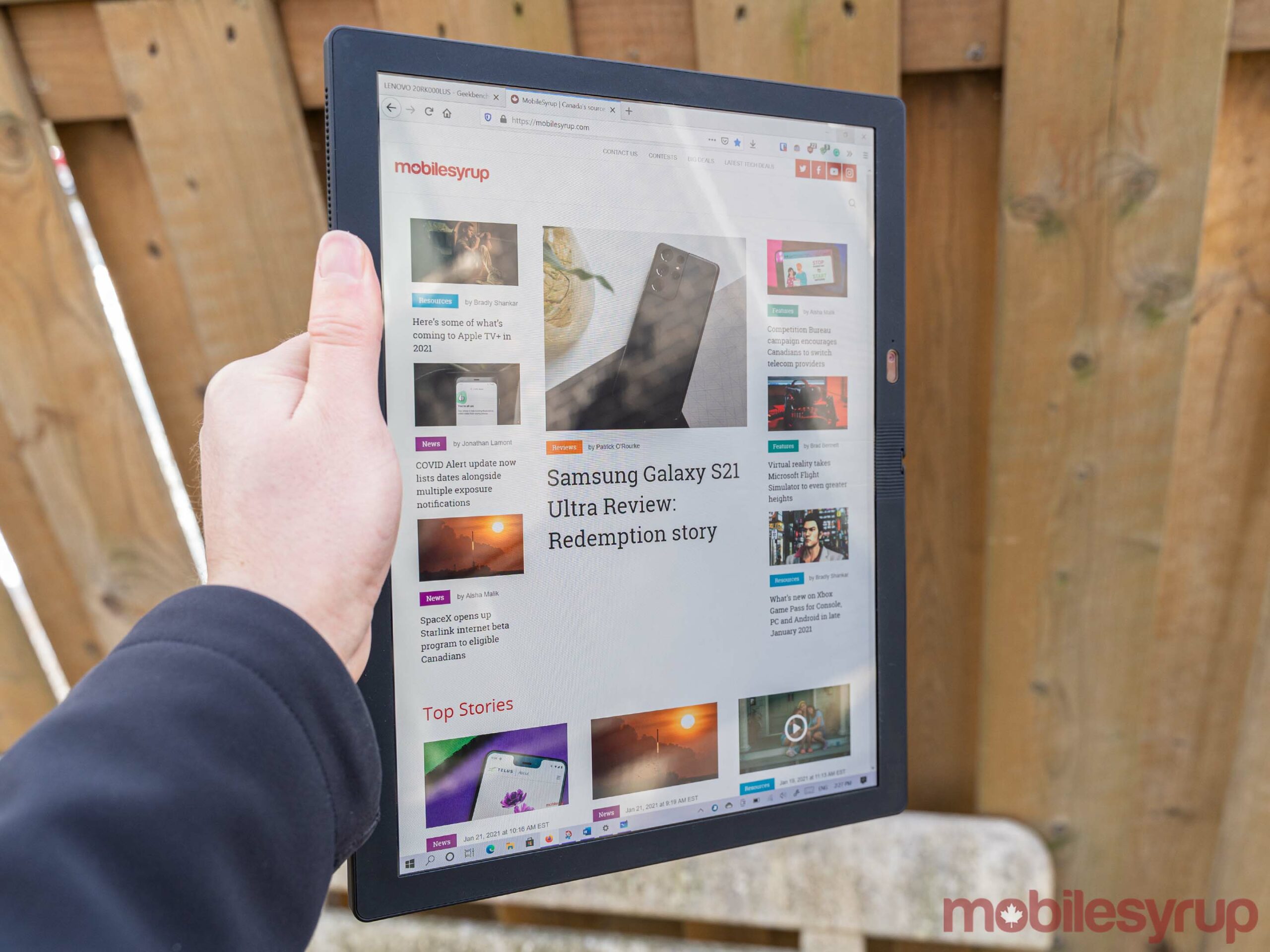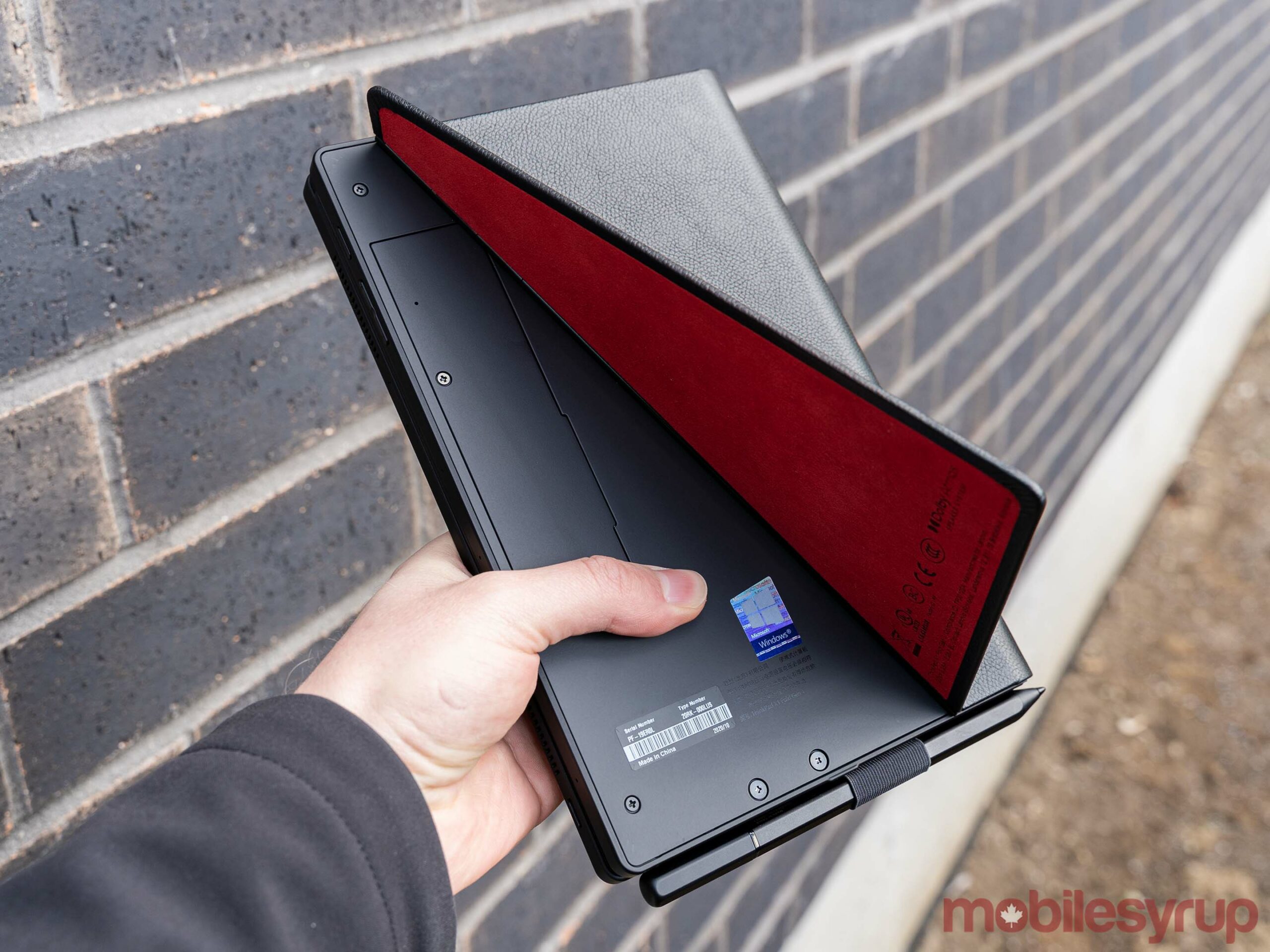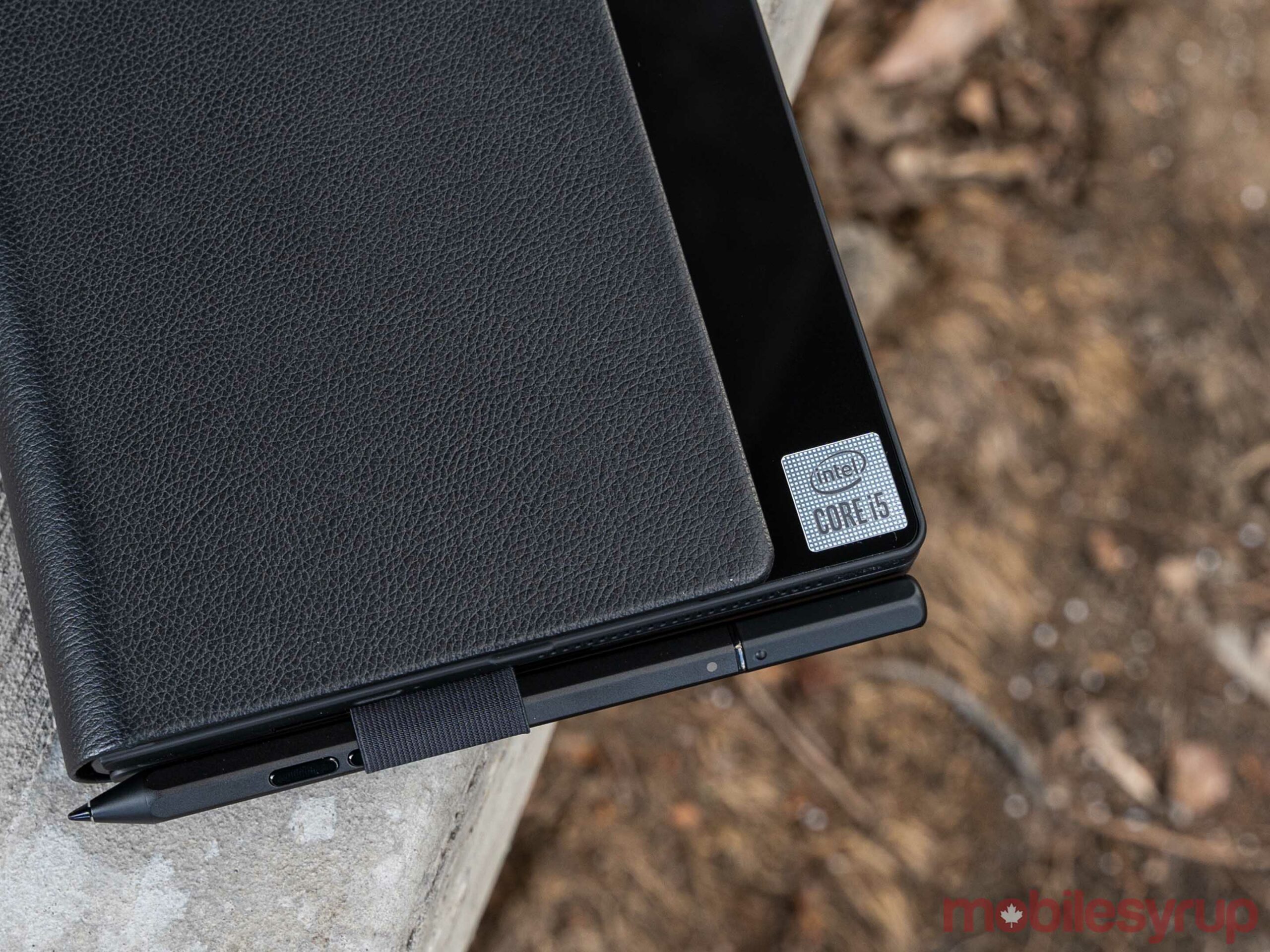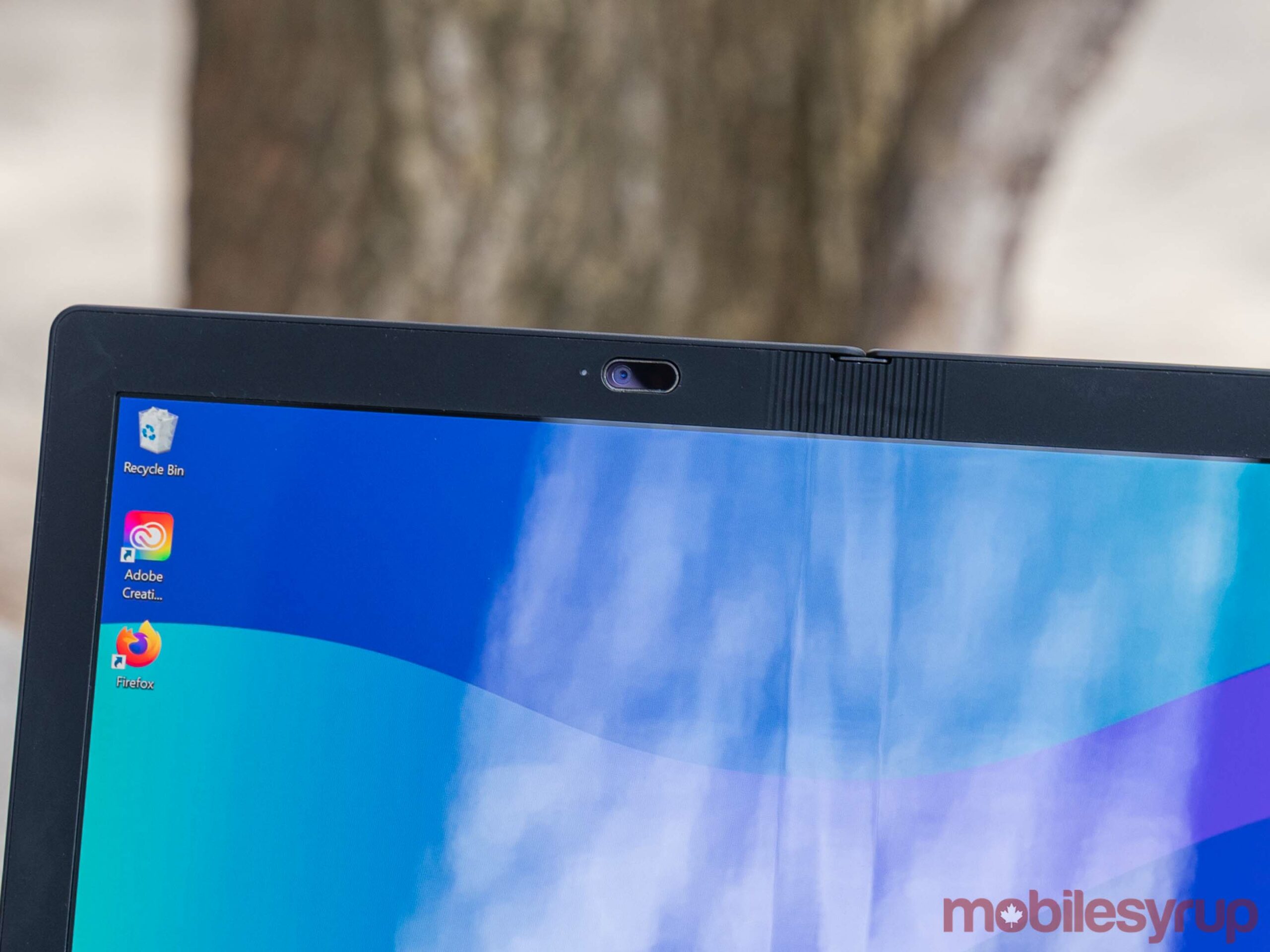
The Pros
- It folds!
- Solid display
- Really exciting concept
The Cons
- Expensive, especially with accessories
- Mediocre battery life
- Performance isn't great
Last year, several manufacturers teased upcoming portable PCs with foldable displays. Intel showed off its ‘Horseshoe Bend’ concept at CES and Lenovo showed off its Thinkpad X1 Fold with a promise to release it in mid-2020. Fast forward to late September, Lenovo followed through and released the Fold (arguably a bit after the promised mid-2020) and MobileSyrup had the opportunity to test one for the last few weeks.
The Thinkpad X1 Fold is a striking device, but also decidedly odd. The first thing I noticed was the strange leather-like back panel. Although the panel is integral to the device, it’s also strangely disconnected — part of it slides when you fold the X1, revealing a slim rectangle of glass. Don’t get me wrong, the X1 Fold looks nice, and the leather back panel feels great. It’s just weird. The screen has hefty bezels going around the outside, and an iPad Pro-like edge that’s squared off with rounded corners, with perforations on the top-left, left and bottom-left edges for venting heat and speaker output.
The design, odd as it is, falls aside quickly when you pick it up and fold it for the first time. I won’t lie — the experience of folding and unfolding this thing is unique and unlike any other PC I’ve tried. For the folding alone, the X1 Fold is an incredible achievement.
However, it’s also disappointing. Yes, it’s a foldable PC — a technical marvel that enthusiasts have dreamed of for years — but I’d hardly count it as useful. Lenovo made several concessions with the X1 Fold to make it foldable and, for many, I think those compromises will rule it out as an option for portable computing. Coupled with an exorbitant price tag, the X1 Fold will be a tough sell to anyone who actually wants to get work done, especially on a budget.
Specs

- Display: 13.3-inch QXGA Foldable 2K (2048 x 1536 pixel resolution) OLED touchscreen, 300 nits brightness
- Processor: Intel Core i5-L16G7
- Memory: 8GB LPDDR4X at 4,267MHz
- Storage: Up to 1TB PCIe M.2 SSD
- Dimensions: 11.5mm x 299.4mm x 236mm / 0.45” x 11.79” x 9.29” (unfolded)
- Weight: Starts at 0.99kg (2.2lbs)
- Camera: 5MP webcam with hybrid infrared sensor
- Operating System: Windows 10 Home or 10 Pro
- Battery: 50Wh with ‘Rapid Charge’ technology (Lenovo estimates 8.5 hours)
- Connectivity: Wi-Fi 6, Bluetooth 5.1, optional 5G/LTE
- Sensors: Gyroscope, accelerometer, proximity sensor
- Ports: 2x USB-C 3.2 Gen 2 (10Gbps), optional Nano SIM slot
- Graphics: Integrated Intel UHD graphics
- Price: Starts at $3,369 in Canada
All about the fold

The X1 Fold opens up like a book and it’s quite adaptable, in part thanks to the wireless keyboard (which isn’t included in the base model).
You can open it flat and use it as a tablet, or pop-up the built-in kickstand to stand the display up. Alternatively, you can bend it like a traditional clamshell laptop and put the keyboard over half the screen, transforming the X1 Fold into a tiny little laptop.
In ‘laptop’ form, the X1 Fold is quite compact and, frankly, a really cute little PC. Initially, I thought the various form factors would make the X1 Fold a portable productivity fiend — the ‘laptop’ form would be great for working while on the go and using the Fold on my lap. When I could be more stationary, such as while sitting at a desk, I could pop off the keyboard, open the kickstand and benefit from a large screen. When I wanted to relax, the Fold could transform into a tablet.

In practice, this didn’t work nearly as well as I’d hoped. For one, Windows 10 doesn’t play well with small screens. While that isn’t Lenovo’s fault, it did make using the X1 Fold’s ‘laptop’ form factor frustrating. Docking the keyboard covers half the display, and the X1 Fold automatically turns off the covered portion. That leaves users with a tiny screen that just isn’t conducive to multi-tasking or productivity in any sense.
The other significant issue I bumped into was the keyboard. Thanks to the size constraints of the X1 Fold, Lenovo had to build a really tiny keyboard. Like so much else with the X1 Fold, it’s simultaneously an engineering marvel and a disappointment. Typing with any degree of efficiency is practically impossible on this device.
Poorly placed ports

For a good chunk of my time with the X1 Fold, I ditched the keyboard entirely (I write for a living, and the keyboard made it far more challenging than I’d like). Instead, I connected a traditional mouse and a mechanical keyboard I had kicking around so I could focus on using the X1 Fold without getting tripped up by the keyboard.
As an aside, two USB-C ports are just barely sufficient for a laptop, but Lenovo could have chosen a better place for at least one of the X1 Fold’s USB-C ports. If you use the X1 with the kickstand, one of the two ports ends up on the bottom of the screen and inaccessible. That left me with one port free, which meant a choice between charging or using my keyboard.
Trust me, you’ll always want a port available for charging. In my testing, the X1 Fold seldom lasted more than three or four hours. For the most part, that included just web browsing with a few tabs open, and maybe some word processing.
Surprisingly capable internals

All that aside, the X1 Fold performed much better than I expected with its Intel Core i5-L16G7 CPU coupled with 8GB of RAM. On the one hand, I’m surprised to even see an Intel chip in such a tiny form factor — ARM chips typically work much better in these types of devices. On the other, I’m glad Lenovo went with Intel, as Windows on ARM still lacks software support. In other words, the Intel CPU lets you run almost any app on the X1 Fold without any issues (unlike with ARM) — but just because you can run something doesn’t mean you should.
For those who care about benchmarks, I ran a Geekbench 5 test. The results weren’t great with a 662 single-core score and 1,766 multi-core, which is far worse than a variety of Windows laptops that cost around half as much as the Fold. For example, both the Microsoft Surface Laptop Go (1,150/3,552) and 2020 Surface Pro X (799/3,137) bested the X1 Fold by significant margins. However, in real-world use, the X1 Fold performed better than the numbers indicate.
From a performance standpoint, most basic Windows tasks should work just fine. Browsing the web was mostly issue free on both Microsoft Edge and Firefox. Office apps also worked fine, and I was even able to install and use Photoshop. I wouldn’t call photo editing on the Fold a great experience, but I could make it work in a pinch. While apps ran fine, I did occasionally encounter bouts of stutter when scrolling and typing. Some of that could be attributed to the wireless keyboard, but even when using wired devices it wasn’t perfectly smooth.
Ultimately, I’d say the performance favours casual tasks over high-level productivity, so keep that in mind if you want to buy the X1 Fold. In my case, the X1 Fold just didn’t have the chops to keep up with my typical workflow. ‘Fine’ performance just doesn’t cut it these days, and there wasn’t anything the Fold could do better or faster than any other computer I had to hand.
Concerns about longevity
When fully unfolded, the X1 Fold boasts a 13.3-inch QXGA Foldable 2K (2048 x 1536 pixel) OLED touchscreen display with 300 nits of brightness and 95 percent coverage of the DCI-P3 colour gamut.
In my testing, I found the X1 Fold was consistently sharp and the panel looked great in most conditions. Really, my only complaint here was the incredibly saturated colour profile. It gave some colours, like reds, oranges and purples, an almost neon vibrancy that I wasn’t a fan of. I couldn’t find a way to tune the display in settings. Overall, it’s a minor issue, but those who value colour accuracy may dislike it.
Another thing I noticed with the display software is it sometimes failed to recognize when the keyboard was attached, and wouldn’t turn off the covered portion of the screen. Turning the Fold off and on again usually set things right.
It’s also worth noting that the X1 Fold generally avoids bumpiness around the section of the screen that bends when you fold it. Other foldables I’ve tried had a mushy, bumpy feel in that area — the X1 Fold, however, felt solid. It’s also difficult to see the display crease when the screen is flat without actively hunting for it. Using the screen while partially folded shows some discolouration around the fold.
However, I do have some concerns about longevity. The first review unit Lenovo provided had a series of dead pixels near the section of the display that folded. Lenovo said it hadn’t encountered similar issues on any of its other X1 Fold units, and the second review unit had no dead pixels at all. While likely a one-off, it does raise some concerns for me.
Accessories make or break it
One troubling trend I’ve noticed in the PC market with alternative form factor devices like the X1 Fold or other 2-in-1s is the accessorization of essential components. If you were to purchase a laptop from any manufacturer, you’d expect it to have a keyboard installed — it’s necessary for the basic use of the device. Buy a computer with a new form factor, however, and suddenly the keyboard costs extra.
Such is the case with the X1 Fold, but perhaps more egregious since the Lenovo Fold Mini wireless keyboard costs an eye-watering $319.99 in Canada (and that’s on top of the already expensive $3,369 base price). If you want the Lenovo Mod Pen for inking and writing, that’s another $139.99. Granted, the next step up from the base X1 Fold includes the accessories at the $3,709 price (it’s about $118 cheaper than buying the base model and the accessories individually), but the $3,709 model is identical to the base model in every way save the included accessories. Really, the $3,709 model is the X1 Fold to buy if you want the full experience.
At the same time, maybe you’re better off skipping Lenovo’s accessories. As mentioned up top, the Fold Mini keyboard is practically unusable for any serious typist. In an effort to fit the keyboard into a tiny form factor that worked with the X1 Fold, Lenovo turned various keys into multi-functional options with ‘layers’ of keys.
That meant commonly-used functions got shafted to lower layers that require arcane key combos to access. Aside from the ‘base’ layer of keys, there’s a second layer accessible by pressing the ‘function’ key and some characters, like the question mark, are even on a third ‘Shift-Function’ layer. Lenovo also messed with the ‘home row’ by pushing the semicolon and apostrophe keys above the ‘Enter’ key to keep the button (in my opinion, unnecessarily) large. Likewise, the trackpad on the keyboard is comically small, but you can mostly avoid it by using the touchscreen instead.
If you can rework your muscle memory and adapt to some of the odd-ball key positions and combos on the Fold Mini, the actual typing experience is fine. There’s very little travel to the keys and they’re also nearly silent.
Despite the flaws, the Fold Mini keyboard is really neat. It attaches to the X1 Fold via magnets and can wireless charge through the Fold. Plus, it sits nicely inside the X1 when you close it, and even has a loop to hold the Mod Pen. The wireless charging keyboard is particularly nice since it has a Micro-USB charging port, while both the X1 Fold and Mod Pen use USB-C for charging.
Speaking of the Mod Pen, you can use it without doing any pairing with the X1 Fold, but the device does prompt you to ‘configure’ it by downloading some Lenovo software. In my testing, I wasn’t able to make the software communicate with the pen at all.
Solid concept with mediocre execution
Lenovo’s X1 Fold is an excellent first attempt, but I think most people would be better off waiting for a second generation Fold. In so many ways, the X1 Fold feels like the future. It’s versatile, you can bend and manipulate it to adapt to nearly any workflow. And yet, when I try to use it, it grinds my workflow to a crawl.
Conceptually, the X1 Fold is really great, and I think that with some fine-tuning, Lenovo will have an incredible device on its hands. As is, the company made too many compromises in favour of folding that leaves the rest of it underwhelming.
Should you fork out close to $4,000 for the X1 Fold? No. Other than folding, there isn’t a single thing the X1 Fold does better than any other portable computing device available now. If you want a productive computer, basically anything out there will cost less and do more.
At the same time, there’s really nothing that truly compares with the X1 Fold. Those who want to be at the cutting edge of technology may find the Fold appealing, and those with lots of money to burn may also want the X1 Fold. But in every practical sense, there’s no reason to buy it.
The Lenovo X1 Fold starts at $3,369 in Canada, or $3,709 if you want the Fold Mini Bluetooth keyboard and Lenovo Mod Pen.
"Conceptually, the X1 Fold is really great, and I think that with some fine-tuning, Lenovo will have an incredible device on its hands."
MobileSyrup may earn a commission from purchases made via our links, which helps fund the journalism we provide free on our website. These links do not influence our editorial content. Support us here.


